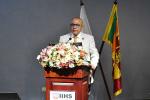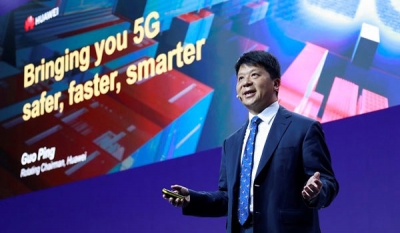His requests come during a keynote speech at Mobile World Congress 2019.
Huawei is the first company to deploy 5G networks at scale, Guo said.
His MWC 2019 keynote address - “Bringing you 5G safer, faster, smarter” - outlined how Huawei has developed the most powerful, simple, and intelligent 5G networks in the world, and argued that such innovation is nothing without security.
He urges the industry and governments to work together and adopt unified cyber security standards.
Summary of MWC 2019 keynote address by Guo Ping, Rotating Chairman, Huawei
1. Innovation
Guo used the first half of his keynote to outline Huawei’s position as the global leader in 5G but asserted that security is the basis of the company’s commitment to innovation.
• “Huawei is the first company that can deploy 5G networks at scale. More importantly, we can deliver the simplest possible sites with better performance.”
• “The more we invest in engineering science, the more value we can create. At Huawei, we can bring powerful, simple, and intelligent 5G networks to carriers anywhere in the world, faster than anyone else. Huawei is the global leader in 5G. But we understand innovation is nothing without security.”
2. Security
In the second half of the keynote, Guo responded to recent allegations directed at Huawei by the U.S. government and called for fact-based regulation, referring to the recommendations made by GSMA, the industry organization for mobile network operators worldwide, for governments and mobile operators to work together.
• “To build a secure cyber environment for everyone, we need standards, we need fact-based regulation, and we need to work together.”
• “To build a system that we all can trust, we need aligned responsibilities, unified standards, and clear regulation.”
• “I fully agree with recent recommendations: Governments and mobile operators should work together to agree upon Europe's assurance testing and certification regime. NESAS is a very good idea and I would recommend extending it to the world.”
• “Huawei has not and will never plant backdoors. And we will never allow anyone else to do so in our equipment.”
• The irony is that the US CLOUD Act allows their governmental entities to access data across borders.
FULL TEXT: Guo Ping's Keynote at MWC Barcelona 2019
Bringing you 5G safer, faster, smarter
Ladies and gentlemen, good morning.
It’s great to see you all again.
There has never been more interest in Huawei. We must be doing something right.
Of course, the past few months have been a challenge for us. On one hand, our 5G solutions are widely recognized in the industry.
On the other hand, there has been a lot of speculation about the security of our 5G solutions.
Today, I would like to talk about Huawei's latest innovations and our views on cyber security.
Innovation – It's all in the details
On the 2018 EU R&D Investment Scoreboard, Huawei ranks number 5 globally. Last year, we invested more than 15 billion US dollars.
This consistent investment has produced many positive results. Through nonstop investment, we can keep providing our customers with new, innovative products and more efficient services.
5G is a perfect example of this.
Powerful. Simple. Intelligent.
Huawei is the first company that can deploy 5G networks at scale.
More importantly, we can deliver the simplest possible sites with better performance.
With 100 megahertz, our 5G can reach more than 14 gigs-per-second; that’s for a single sector.
We are at the leading edge of performance.
Strong capacity also needs strong transmission equipment.
• If fiber is available, we only need to install a blade, attach one fiber, and we can bring bandwidth up to 200 Gbps. It's incredible.
• If fiber is not available, carriers can use microwave. However, the bandwidth of traditional microwave is only 1 Gbps. To address this problem, we use innovative architecture to boost that bandwidth to 20 Gbps.
• With our 5G smartphone and CPE, Huawei is able to provide end-to-end 5G solutions. We have begun to help carriers deploy 5G at scale.
Proven in field tests and commercial use
Last month, Zealer published a report, saying that Huawei's 5G is 20 times faster than the so-called 5G in the US.
That's in field tests. In commercial use, it is not 20 times faster, but it's still much, much faster.
So I fully understand what President Donald Trump said last week.
The United States needs powerful, faster, and smarter 5G.
In the two charts on the left, we have the results from IMT-2020’s phase 3 tests in China.
As you can see, Huawei is far ahead of the game when it comes to single site throughput.
The third chart compares the speeds of a commercial 5G network deployed by several vendors.
This is a real customer network. On Huawei 5G, single user speed reaches 1.3 Gbps.
Powerful
Innovation is in the details.
Let's start with capacity.
• For example, with performance algorithm, we can more than triple cell throughput.
• For hardware, our 5G chips support 64 channels, the highest in the industry. We have also increased the computing power of these chips by 2.5 times.
For microwave, we can support 10 times greater transmission bandwidth than other solutions on the market.
Little by little, we are pushing the physical limits of our technology.
Simple
We are also making sites as simple as possible, without sacrificing performance.
For example, if we made 64T antennas with old techniques, one 5G antenna would be bigger than a door.
Can you imagine installing that? If we put one here on the beach, it would be blown down.
To address this issue, we are using new materials.
We have reduced the number of components by 99%, and with lighter covers, we can reduce weight by 40%.
These new AAUs are as wide as a backpack and very strong.
They can survive grade-15 typhoons. This happened in Shenzhen last year.
Installation is super easy. We can install them directly on a 4G site, or even on a lamp pole.
Simple sites greatly reduce carrier CAPEX and OPEX. In Europe, where space is limited, we can help you save 10,000 euros on site rental, every site, every year.
Intelligent
In the telecom industry, someone said we are using 5G networks of the 21st century.
However, network Operation and Maintenance is still in the 18th century.
Let's look at one figure. Globally, 70% of network faults are from human limitations.
To make life easier for carriers, our goal is to build intelligent networks.
Last October, Huawei launched the world’s most powerful AI chips: Ascend 910 and Ascend 310.
We can use these to bring intelligence to all scenarios, and reduce computing power costs for carrier networks.
Building on these chips, Huawei has developed many algorithms and models for carrier networks.
With AI, we can increase resource efficiency, make O&M easier, and reduce power consumption for telecom networks.
Conclusion
The more we invest in engineering science, the more value we can create.
At Huawei, we can bring powerful, simple, and intelligent 5G networks to carriers anywhere in the world, faster than anyone else.
Huawei is the global leader in 5G. But we understand innovation is nothing without security.
And that brings me to my second topic.
Cyber security
Prism
Prism, prism on the wall.
Who’s the most trustworthy of them all?
It’s an important question to ask. And if you don’t understand this question, go ask Edward Snowden.
We can’t use prisms, crystal balls, or politics to manage cyber security. It's a challenge we all share.
Unified standards and aligned responsibilities
To build a system that we all can trust, we need aligned responsibilities, unified standards, and clear regulation.
Responsibility
There are three areas of responsibility:
• Technology providers have responsibility.
• Carriers have responsibility.
• The industry and regulators have responsibility.
Technology providers
Let me start with technology providers, like us.
For technology providers, our responsibility is to comply with standards and build secure equipment.
With 5G, we have made a lot of progress over 4G, and we can proudly say that 5G is safer than 4G.
As vendors, we don't operate carrier networks, and we don't own carrier data. Our responsibility, what we promise, is that we don't do bad things.
Here, let me say this as clearly as possible: Huawei has not and will never plant backdoors. And we will never allow anyone to do so in our equipment.
We take this responsibility very seriously.
Carriers
Carriers are responsible for the secure operations of their own networks.
5G networks are private networks. The boundaries between different networks are clear. Carriers can prevent external attacks with firewalls and security gateways.
For internal threats, carriers can manage, monitor, and audit all vendors and partners to make sure their network elements are secure.
Industry and regulators
Finally, as an industry, we all need to work together on standards. This is our shared responsibility.
To build safer networks, we need to standardize cyber security requirements. And these standards must be verifiable for all vendors and all carriers.
NESAS is jointly defined by GSMA and 3GPP, and it is a very good idea. Huawei fully supports this scheme.
In fact, 3GPP's security standards were created with the support of many government security agencies.
These agencies have strong capabilities to verify 5G security.
So, I fully agree with recent recommendations: Governments and mobile operators should work together to agree what this assurance testing and certification regime for Europe will be.
And I would recommend extending NESAS to the world.
Let the experts decide whether networks are safe or not.
Best Technology, Greater Security
Huawei has had a strong track record in security for three decades, serving three billion people around the world.
The US security accusation on our 5G has no evidence, nothing.
The irony is that the U.S. CLOUD Act allows their governmental entities to access data across borders.
So, for best technology and greater security, choose Huawei.
MWC 2019 was held from February 25 to February 28 in Barcelona, Spain.
Huawei showcased its products and solutions at booth 1H50 in Fira Gran Via Hall 1, booth 3I30 in Hall 3, the Innovation City zone in Hall 4, and booths 7C21 and 7C31 in Hall 7.
For more information, please visit carrier.huawei.com/en/events/mwc2019 .






















